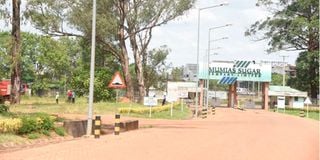Bitter taste in the mouth: A sad story of the local sugar industry

Mumias Sugar Company in Western Kenya.
What you need to know:
- The first milling factory was established in 1922 at Miwani, near Kisumu.
- The shortage of sugarcane for milling by factories has led to depressed output, the available supply able to satisfy only 20 per cent of the local daily demand.
The sugarcane farmer in Kenya is like an innocent person repeatedly subjected to mob justice. Despite sugar being a commodity with constant demand throughout the country, the primary producer is buffeted from all sides by forces that keep sapping his energy and patience while offering uncertain returns on his investment.
For a product with a steady market and currently fetching high retail prices, one would expect good tidings across the sugar value chain, but this is still a mirage.
Sugarcane (Saccharum Hybrids) is a crop indigenous to Kenya but it was mainly used for the low-key brewing of traditional liquor until its introduction as an industrial crop by the colonial government in 1902.
The first milling factory was established in 1922 at Miwani, near Kisumu. By then, policies on sugarcane production were based on colonial law, which allowed Asians but barred Africans from growing sugarcane until this was overturned after Independence under Sessional Paper No. 10 of 1965.
Government gradually set up factories along Kenya’s sugar-belt in Western and Nyanza provinces that saw the growth of sugarcane production, culminating in the country becoming a net sugar exporter by the 1970s. A decline in productivity and profitability negated the gains within a decade, a situation Kenya has yet to recover from to date.
This is a sector in distress. The shortage of sugarcane for milling by factories has led to depressed output, the available supply able to satisfy only 20 per cent of the local daily demand. According to the Sugar Directorate, the total tonnage of sugar milled in the country dropped by 36 per cent between January and April this year.
Almost all the millers operate below capacity, depending on smallholder farmers for their raw material supply. Sugarcane requires time to mature, with most varieties taking between 18-24 months before it is ready for harvesting.
At individual level, this is a long period of lean pockets for the farmers, sometimes accompanied by low staple food stocks since most of their land is usually committed to the sugarcane crop. Premature harvesting of cane is not uncommon due to the demand by factories and farmers’ dire economic positions.
Some years ago, millers in the Western region got involved in cutthroat competition for supplies upon the entry of a private miller on the scene. The original millers used contracted farmers in designated regions. The farmer was therefore tied down to a particular miller, breeding delays in payment for cane supplies to the factories.
The newcomer disregarded these boundaries and picked up cane from any obliging farmer, paying better prices promptly and at correct tonnage while upscaling extension services. The miller charged the farmer a flat rate for the transportation of cane from their farms to the factory irrespective of distance, with the farmer allowed to use his own means of delivery if he so wished. The other players had to up their game but such changes are still a drop in the ocean for the beleaguered Kenyan farmer.
To maximise tonnage produced per acre, the farmer needs to properly prepare the land for planting, which may require machinery and purchase of quality cane seed and other inputs such fertiliser, herbicides and pesticides. The financial investment includes labour since sugarcane farming, though not as injurious as, say, tobacco farming, is a labour-intensive undertaking.
Many farmers usually decide to put their land to alternative use due to financial constraints and the dearth of funding avenues. Those who opt to take the exorbitant service loans offered by some of the millers may shed a tear upon receipt of their payment schedules after cane delivery to the factory.
It is also disheartening to see a local farmer travel many miles from Trans-Mara to Ndhiwa in Homa Bay to follow up on his cane since the operations of factories closer home are usually on and off.
The mismanagement of sugar factories, coupled with policy limitations, has been a silent killer of the sector. Corruption and nepotism have resulted in once profitable companies like Mumias Sugar Company, going into receivership while the huge potential of the Coast Province, especially Kwale, remains untapped.
Government has been slow in addressing the sugarcane development woes, choosing to bridge the shortage gap by opening windows for the private importation of duty-free sugar from within and outside the Comesa region, a fertile breeding ground for unscrupulous cartels.
It is not surprising that the cost of production of sugar in Kenya is almost double that of other counties in the region, the result of the high cost of farm inputs; a taxation regime that raises the general cost of doing business in Kenya; and loss of produce during transportation and at factory level due to inefficient machinery and processes.
There are reports of seepage of cheaper, illegal sugar into Kenya from neighbouring countries, with some millers and other shady traders said to be re-packaging it as local brands before releasing it into the market, for abnormal profit.
It is possible to go back to the glorious days of the 1970s but with lack of incentives for farmers, half-hearted enactment of policies governing sugarcane production and the unfettered rise of sugar cartels in the country, the chaos in the sugar industry looks deliberate.




